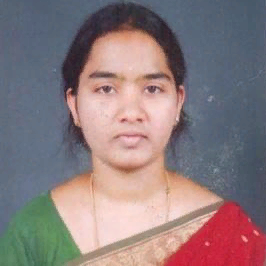
Saka Kezia
Work place: Dept. of ECE, CIET Rajahmundry, JNTUK, A.P, INDIA
E-mail: sakakezia1981@gmail.com
Website:
Research Interests: Engineering, Computational Engineering
Biography
Saka Kezia received the B.Tech (ECE) degree from JNTU College of Engineering, JNT University, Kakinada in 2002. She received M.Tech IIT Madras, India in 2004. She is having nearly 8 years of teaching and industrial experience. She is currently working as Associate Professor, Dept of E.C.E, CIET, Rajahmundry. She is pursuing Ph.D from JNT University, Kakinada in ECE under the guidance of Dr. V. Vijaya Kumar. She is a life member of ISTE, IETE, Red Cross Society and she is a member of SRRF-GIET, Rajahmundry. She has presented 8 papers in various Inter National conferences proceedings. She has published 6 International journal papers.
Author Articles
Morphological Multiscale Stationary Wavelet Transform based Texture Segmentation
By Mosiganti Joseph Prakash Saka Kezia V.Vijayakumar
DOI: https://doi.org/10.5815/ijigsp.2014.08.05, Pub. Date: 8 Jul. 2014
Image segmentation is an important step in several computer vision applications. The segmentation of images into homogeneous and meaningful regions is a fundamental technique for image analysis. Textures occupy a vital role in a wide range of computer vision research fields; from microscopic images to images sent down to earth by satellites, from the analysis of multi-spectral scan images to outdoor scenes, all consist of texture. Although several methods have been proposed, less work has been done in developing suitable techniques for segmentation of texture images. After a careful and in-depth survey on wavelet transforms, the present study found that efficient numerical solutions in the signal processing applications can be found using Stationary Wavelet Transform (SWT). SWT is redundant, linear and shift invariant, that’s why it gives a better approximation than the DWT. In this paper a novel texture segmentation method based on “SWT and Textural Properties” is proposed. Multi scale SWT with Textural Properties and morphological treatment is used in the present study to detect fine edges from texture images for a fine segmentation.
[...] Read more.A Color-Texture Based Segmentation Method To Extract Object From Background
By Saka Kezia I. Santi Prabha V.Vijaya Kumar
DOI: https://doi.org/10.5815/ijigsp.2013.03.03, Pub. Date: 8 Mar. 2013
Extraction of flower regions from complex background is a difficult task, it is an important part of flower image retrieval, and recognition .Image segmentation denotes a process of partitioning an image into distinct regions. A large variety of different segmentation approaches for images have been developed. Image segmentation plays an important role in image analysis. According to several authors, segmentation terminates when the observer's goal is satisfied. For this reason, a unique method that can be applied to all possible cases does not yet exist. This paper studies the flower image segmentation in complex background. Based on the visual characteristics differences of the flower and the surrounding objects, the flower from different backgrounds are separated into a single set of flower image pixels. The segmentation methodology on flower images consists of five steps. Firstly, the original image of RGB space is transformed into Lab color space. In the second step 'a' component of Lab color space is extracted. Then segmentation by two-dimension OTSU of automatic threshold in 'a-channel' is performed. Based on the color segmentation result, and the texture differences between the background image and the required object, we extract the object by the gray level co-occurrence matrix for texture segmentation. The GLCMs essentially represent the joint probability of occurrence of grey-levels for pixels with a given spatial relationship in a defined region. Finally, the segmentation result is corrected by mathematical morphology methods. The algorithm was tested on plague image database and the results prove to be satisfactory. The algorithm was also tested on medical images for nucleus segmentation.
[...] Read more.Other Articles
Subscribe to receive issue release notifications and newsletters from MECS Press journals